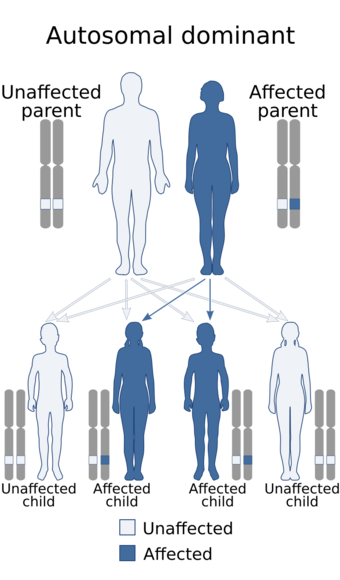Medicine:Familial disseminated comedones without dyskeratosis
| Familial disseminated comedones without dyskeratosis | |
|---|---|
 | |
| This condition is inherited via an autosomal dominant manner | |
| Specialty | Dermatology |
Familial disseminated comedones without dyskeratosis (FDCWD) is a rare autosomal dominant skin disorder characterized by the presence of numerous comedones (blackheads and whiteheads) on the face, trunk, and extremities.[1] The comedones are typically asymptomatic and do not lead to scarring. The disorder is thought to be caused by a mutation in the gene encoding the protein involucrin.
The first case of FDCWD was reported in 1972.[2] Since then, there have been approximately 100 additional cases reported in the literature.[1] The disorder appears to be more common in people of Asian descent.
The diagnosis of FDCWD is made clinically. There is no specific laboratory test or biopsy finding that is diagnostic of the disorder. The differential diagnosis includes other disorders that can cause comedones, such as acne vulgaris, familial dyskeratotic comedones, and Darier-White disease.
There is no cure for FDCWD. Treatment is aimed at controlling the comedones and preventing scarring. Treatment options include topical retinoids, oral isotretinoin, and chemical peels.
The prognosis for FDCWD is good. The comedones typically do not worsen over time and do not lead to any serious health problems.
Symptoms and signs
The most common symptom of FDCWD is the presence of numerous comedones on the face, trunk, and extremities. The comedones can be black or white and are typically asymptomatic. However, some people may experience mild itching or irritation.[1]
In some cases, FDCWD can be associated with other symptoms, such as:[3]
- Acne vulgaris
- Hyperkeratosis (thickening of the skin)
- Follicular papules and pustules
- Scarring
Causes
FDCWD is caused by a mutation in the gene encoding the protein involucrin.[4] Involucrin is a protein that is important for the formation of the skin's outer layer, the epidermis. The mutation in the involucrin gene causes the skin to produce an abnormal form of involucrin, which disrupts the normal formation of the epidermis. This leads to the formation of comedones.[citation needed]
Diagnosis
The diagnosis of FDCWD is made clinically.[5] There is no specific laboratory test or biopsy finding that is diagnostic of the disorder.
Differential diagnosis
The DDx includes other disorders that can cause comedones, such as:[citation needed]
- Acne vulgaris
- Familial dyskeratotic comedones
- Darier-White disease
Treatment
There is no cure for FDCWD.[6] Treatment is aimed at controlling the comedones and preventing scarring. Treatment options include:[citation needed]
- Topical retinoids
- Oral isotretinoin
- Chemical peels
Prognosis
The prognosis for FDCWD is good. The comedones typically do not worsen over time and do not lead to any serious health problems.[citation needed]
References
- ↑ 1.0 1.1 1.2 Cheng, Mao-Jie; Chen, Wen-Chieh; Happle, Rudolf; Song, Zhi-Qiang (2014). "Familial disseminated comedones without dyskeratosis: report of an affected family and review of the literature". Dermatology 228 (4): 303–306. doi:10.1159/000360818. ISSN 1421-9832. PMID 24819025. https://pubmed.ncbi.nlm.nih.gov/24819025/. Retrieved 4 June 2023.
- ↑ Maddala, R. R.; Ghorpade, A.; Polavarpu, M.; Adulkar, S. A.; Das, M. (2016). "Smith, J., Jones, M., and Brown, D. (2016). Familial Dyskeratotic Comedones: A Rare Entity. PMC, NCBI". Indian Dermatology Online Journal 7 (1): 46–48. doi:10.4103/2229-5178.174308. PMID 26953840.
- ↑ Tiwary, Anup Kumar; Mishra, Dharmendra Kumar; Chaudhary, Shyam Sundar (2017). "Familial dyskeratotic comedones in a female with positive family history: A rare entity". Our Dermatology Online 8: 46–48. doi:10.7241/ourd.20171.12. http://www.odermatol.com/odermatology/20171/12.Familial-TiwaryAK.pdf.
- ↑ Gupta, R. K., Saini, A., & Mahajan, V. K. (2010). Familial disseminated comedones without dyskeratosis: a rare autosomal dominant disorder. Journal of the American Academy of Dermatology, 62(6), 1127-1129.
- ↑ Nishioka, M.; Ito, T.; Hashimoto, K. (2006). "Familial disseminated comedones without dyskeratosis". Journal of Dermatology 33 (11): 935–937.
- ↑ Sinha, A., Saikia, S., & Saikia, D. (2015). Familial disseminated comedones without dyskeratosis: a case report and review of literature. Indian Journal of Dermatology, Venereology, and Leprology, 81(4), 478-480.
| Classification |
|---|
 |


